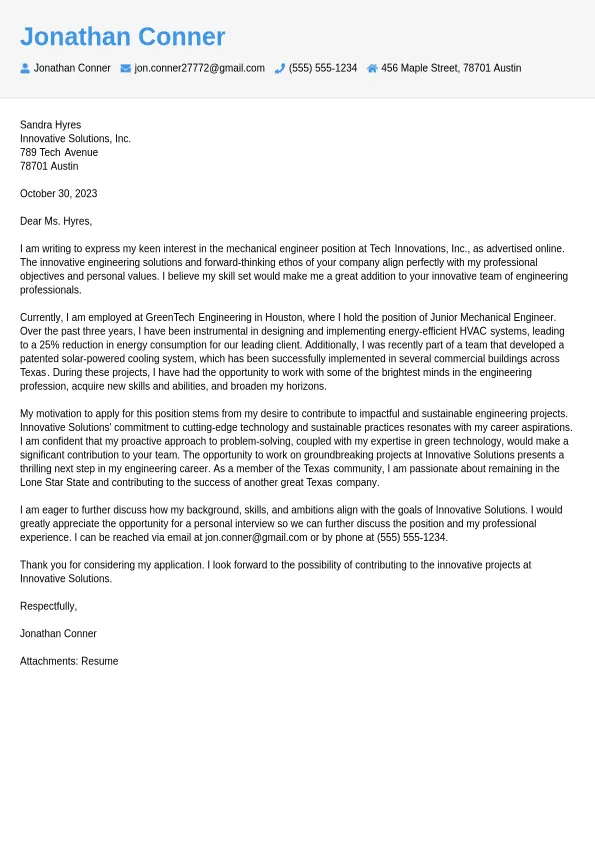Understanding the Engineering Cover Letter
An engineering job cover letter is your first impression on a potential employer, a crucial document that complements your resume and highlights your qualifications, skills, and experiences. Unlike a resume, which provides a factual overview of your career, a cover letter allows you to articulate your interest in the specific role, explain how your skills align with the company’s needs, and showcase your personality. It’s your chance to make a compelling case for why you are the best candidate and to demonstrate your communication skills, which are vital in the engineering field. A well-crafted cover letter increases your chances of getting an interview and ultimately, landing your dream engineering job. Remember, it is not just about listing your qualifications but about demonstrating your understanding of the company and your passion for the field of engineering.
Key Components of an Engineering Cover Letter
Several key components are essential for a successful engineering cover letter. These elements work together to present you as a well-rounded and qualified candidate. It is important to ensure that each section is clearly defined and effectively communicates your value to the employer. By paying close attention to these elements, you can create a cover letter that stands out and makes a positive impact on the hiring manager.
Contact Information
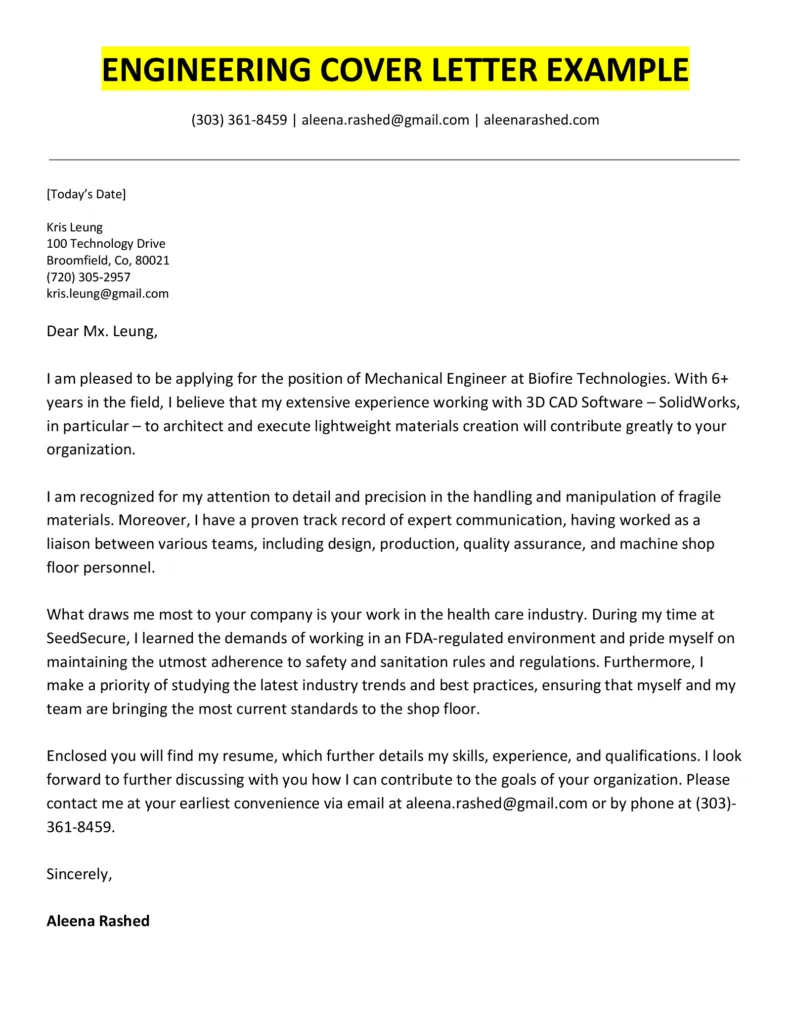
Start with your contact information at the top left, including your name, phone number, email address, and optionally, your LinkedIn profile URL. This ensures the hiring manager can easily reach you. Make sure this information is up-to-date and professional. Verify your email address works and is checked regularly. If you have a professional website or online portfolio, include it as well.
Date
On the same line or below your contact information, include the date you are submitting the cover letter. This provides context and shows the letter’s timeliness. Use a standard date format, such as Month, Day, Year.
Employer’s Information
Below the date, include the hiring manager’s name (if known), their title, the company name, and the company’s address. Addressing the cover letter to a specific person shows you’ve done your research and demonstrates a personal touch. If you can’t find a specific name, use a professional salutation like “Dear Hiring Manager.”
The Introduction
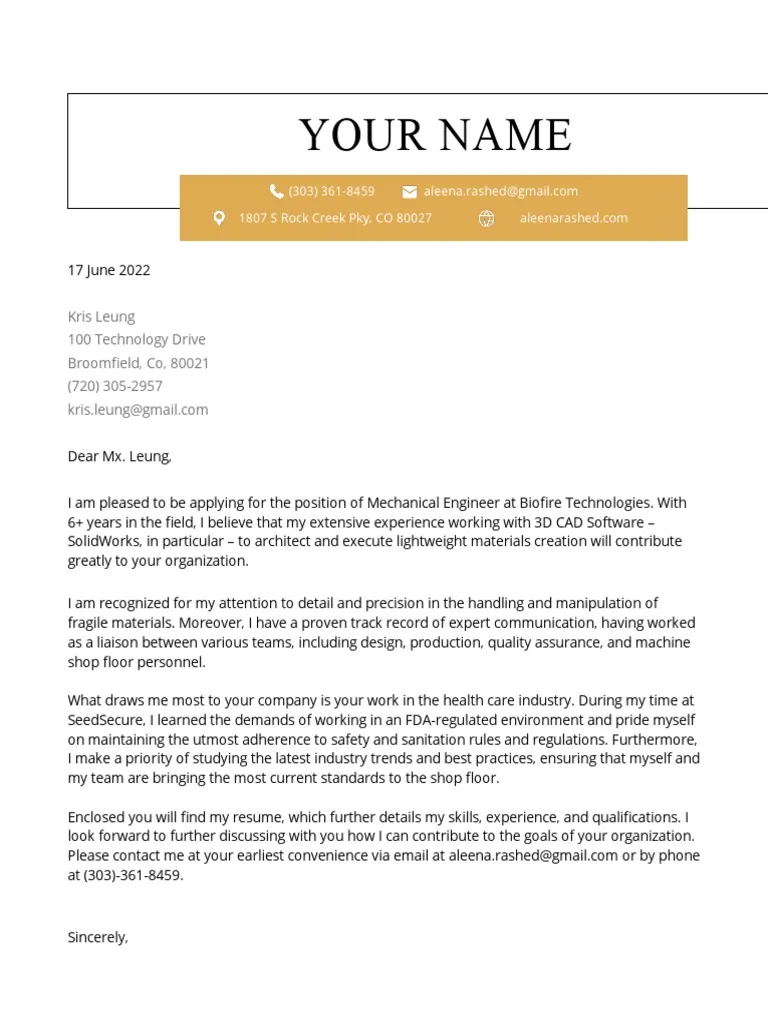
The introduction is your opportunity to grab the reader’s attention. State the position you are applying for and how you learned about the opportunity. Briefly mention why you are interested in the role and the company. Showing enthusiasm and a clear understanding of the job requirements from the start sets a positive tone for the rest of the letter. Avoid generic opening lines and be specific about the position and the company.
Highlighting Your Engineering Skills and Experience
This section forms the core of your cover letter, where you connect your skills and experience to the job requirements. Focus on providing concrete examples of your achievements and skills, using the STAR method (Situation, Task, Action, Result) to illustrate how you’ve solved problems or contributed to projects. This section should be well-organized, highlighting relevant skills and experiences to demonstrate your suitability for the position. Quantify your achievements whenever possible to showcase your impact.
Technical Skills
List your technical skills relevant to the job, such as proficiency in specific software, design tools, programming languages, or engineering principles. Provide examples of how you’ve used these skills in previous projects or roles. Tailor this section to the specific requirements mentioned in the job description. This demonstrates that you have the necessary technical expertise to excel in the role. Ensure your skills align with the company’s needs, showcasing your capabilities effectively.
Project Experience
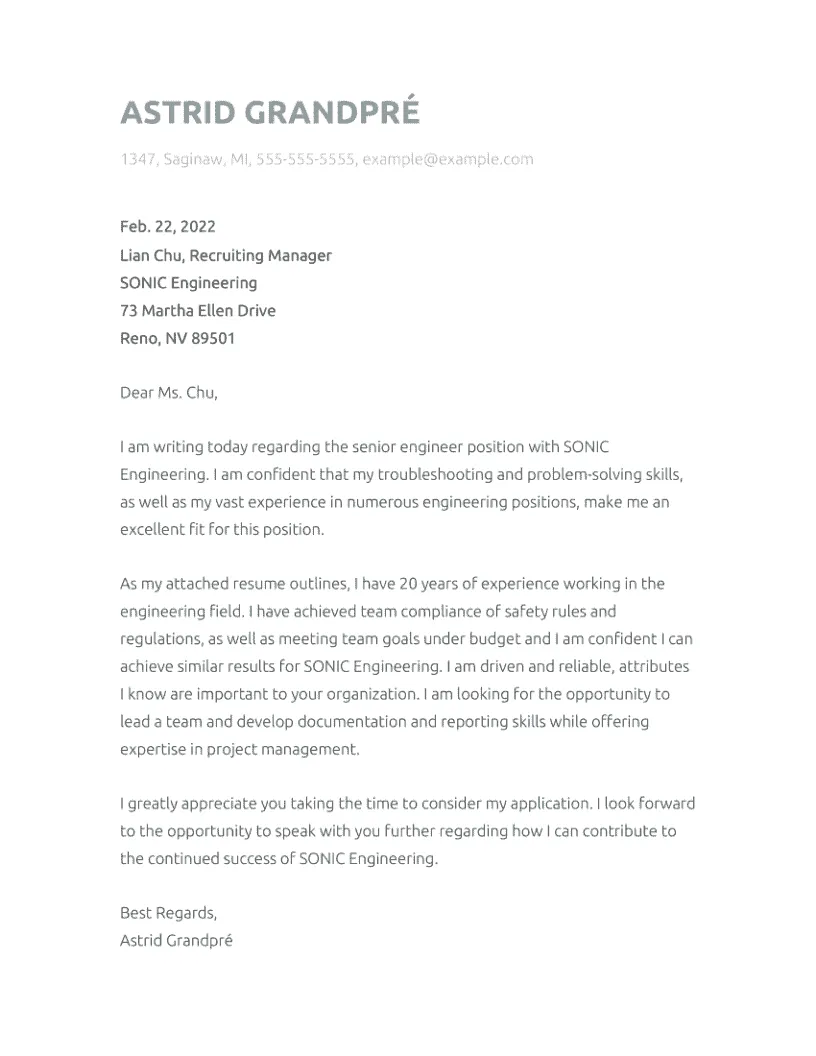
Describe relevant projects you’ve worked on, including your role, the project’s goals, your responsibilities, and the outcomes. Provide specific examples and details to showcase your contributions and the impact of your work. Mention any challenges you overcame and the lessons learned. This section provides concrete evidence of your practical experience and your ability to apply your engineering knowledge in real-world scenarios. Use clear, concise language to describe your projects and accomplishments.
Quantifiable Achievements
Whenever possible, quantify your achievements to demonstrate your impact. Use numbers, percentages, and other metrics to illustrate your successes. For example, you could mention how you improved efficiency by a certain percentage, reduced costs by a specific amount, or increased project completion rates. Quantifiable achievements provide concrete evidence of your value and make a stronger impression on the hiring manager. This provides a clear understanding of the value you bring to the company.
Showcasing Your Soft Skills
While technical skills are crucial, soft skills are equally important in the engineering field. They determine your ability to work collaboratively, solve problems effectively, and communicate ideas clearly. Highlight soft skills that align with the job requirements and provide specific examples to illustrate these skills in action. Emphasizing these skills demonstrates that you are not only technically proficient but also a well-rounded professional who can contribute positively to the team. These soft skills are often key differentiators between candidates.
Communication Skills
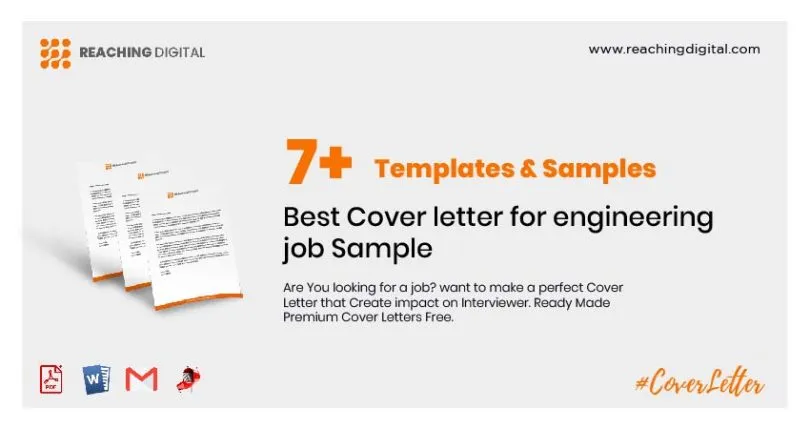
Engineers must be able to communicate complex ideas clearly and concisely, both verbally and in writing. Provide examples of how you’ve effectively communicated with team members, clients, or stakeholders. This might include presenting project updates, writing technical reports, or leading discussions. Clear communication is essential for project success and collaboration. Demonstrate your ability to explain technical concepts in a way that everyone can understand, including non-technical audiences. Image of engineer presenting project results.
Teamwork and Collaboration
Engineering projects often involve teamwork, so highlight your ability to work effectively in a team environment. Describe your experience collaborating with others to achieve common goals, resolving conflicts, and contributing to a positive work environment. Mention any leadership roles you’ve held or any contributions you’ve made to improve team performance. Provide examples of your ability to build relationships and work harmoniously with diverse teams.
Problem-Solving Abilities
Engineering is all about problem-solving. Describe your ability to identify and analyze problems, develop creative solutions, and implement those solutions effectively. Provide examples of how you’ve tackled challenges, learned from failures, and improved processes. Show how you apply your analytical skills and your ability to think critically to solve complex problems. Highlight your approach to problem-solving and your commitment to continuous improvement.
Tailoring Your Cover Letter
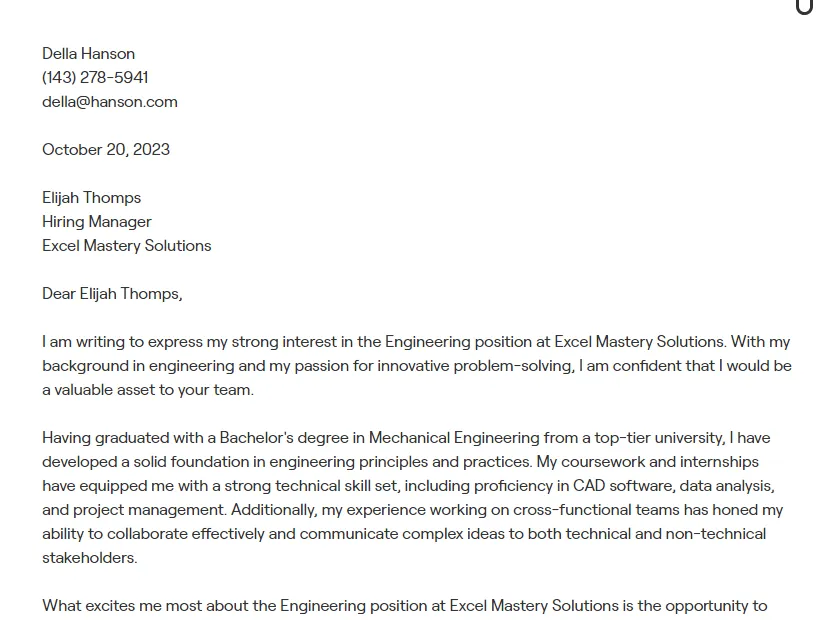
Customizing your cover letter for each job application is essential. Generic cover letters often fail to impress hiring managers. Tailoring your letter demonstrates your genuine interest in the specific role and the company. Personalize your letter to reflect the job description, company culture, and your relevant skills and experiences. Customization makes your application stand out and increases your chances of getting an interview. This shows your dedication to the job.
Researching the Company
Before writing your cover letter, research the company thoroughly. Understand their mission, values, and recent projects. This knowledge will help you tailor your letter to their specific needs and demonstrate your genuine interest. Explore their website, social media, and recent news articles to gain insights into their culture and goals. Mention specific projects or initiatives that resonate with your own interests and experiences. This shows you understand their needs and have a genuine interest in the company.
Matching Skills to Job Requirements
Carefully review the job description and identify the key skills and qualifications required for the role. Match your skills and experiences to these requirements. Use the same keywords and phrases from the job description in your cover letter to demonstrate your alignment with their needs. Provide specific examples of how you’ve used these skills in the past. This shows that you meet the job requirements and are a good fit for the role. This is critical to get the employer’s attention.
Formatting and Structure
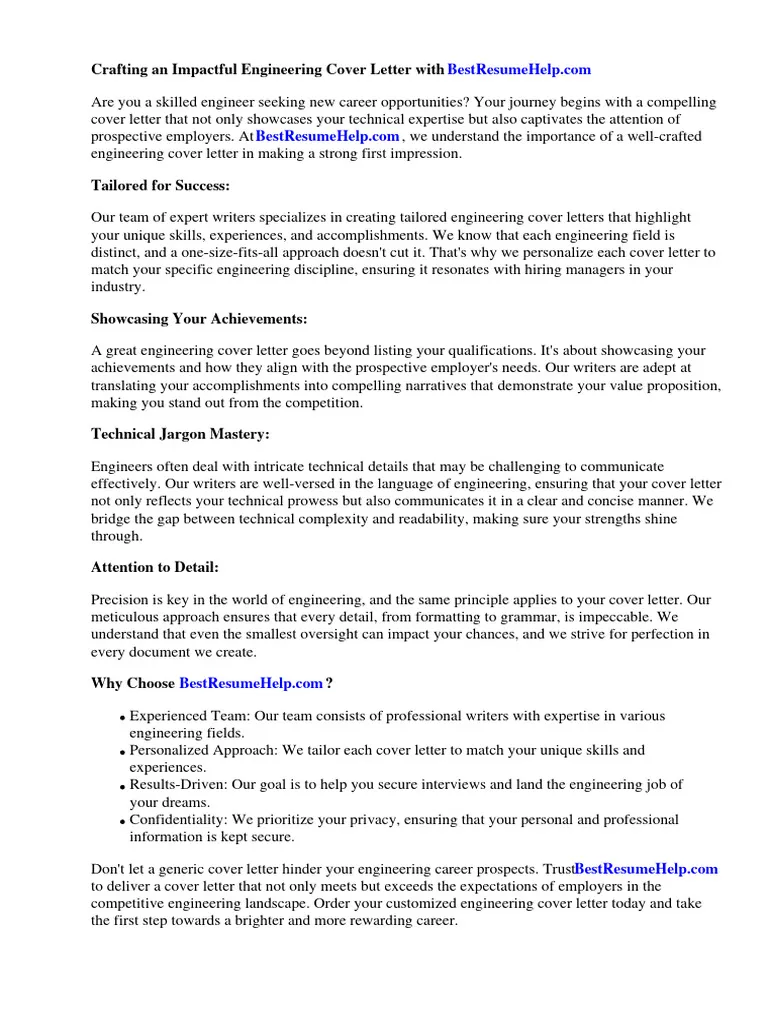
The formatting and structure of your cover letter are as important as its content. A well-formatted letter is easy to read and creates a professional impression. Maintain a consistent format throughout your letter and pay attention to the layout and appearance. A professional, clean format shows that you pay attention to detail, a vital skill for any engineer. A well-structured cover letter makes your content more accessible and helps to keep the reader engaged.
Professional Tone and Language
Use a professional and formal tone throughout your cover letter. Avoid slang, jargon, and overly casual language. Maintain a polite and respectful tone, even when highlighting your achievements. Be clear, concise, and direct in your writing. Ensure your language is appropriate for the workplace and reflects your professionalism. Review your writing for any grammatical errors and typos, as they can undermine your credibility. Image of writing engineering cover letter.
Proofreading and Editing
Proofreading and editing are essential steps in the writing process. Carefully review your cover letter for any errors in grammar, spelling, punctuation, and formatting. Have someone else proofread your letter as well, as a fresh pair of eyes can often catch mistakes you might miss. A polished cover letter demonstrates attention to detail and professionalism. Correcting these errors can boost your overall credibility and improve your chances of getting an interview.
Essential Tips for Success
To increase your chances of success, consider these essential tips. These tips will help you craft a cover letter that stands out. Following these tips can help you make a great first impression and increase your chances of landing an interview and, ultimately, the job.
Keywords Optimization
Use keywords from the job description throughout your cover letter. This helps applicant tracking systems (ATS) identify your application as a good match. Integrate keywords naturally and avoid keyword stuffing. This helps the employer find you more easily. Carefully integrate keywords to demonstrate your suitability and match the company’s needs.
Call to Action
End your cover letter with a clear call to action. Express your interest in an interview and how you can contribute to the company. Provide your availability for an interview or any other relevant information. Ensure the hiring manager knows the next steps to take to move forward in the application process. Encourage them to contact you and provide them with contact information if they need any additional details.
Following Up
If you don’t hear back from the employer within a reasonable timeframe, consider sending a follow-up email. Express your continued interest in the position and reiterate your qualifications. This demonstrates your enthusiasm and initiative. Keep your follow-up email brief and professional, and reiterate your interest in the position. Following up can show your persistence and commitment, which are good qualities in an engineer. Be polite and concise in your communication.
Engineering Cover Letter Examples
Reviewing cover letter examples can help you understand how to structure your own letter and tailor it to the specific job. While each cover letter should be unique, these examples provide templates and ideas to inspire you. You can find many examples online, tailored to different engineering fields and experience levels. Consider these examples as guides.
Example 1 Mechanical Engineering
This is an example of a cover letter for a mechanical engineering position. [Provide a brief example or a link to one]. This example should show how a candidate with a mechanical engineering background can showcase skills. Highlight relevant experience in areas like design, analysis, and manufacturing. Use this as a guideline for your own writing.
Example 2 Electrical Engineering
This is an example cover letter for electrical engineering roles. [Provide a brief example or a link to one]. Emphasize skills in areas like circuit design, electronics, and power systems. Tailor your language to align with the job description and company needs. Consider relevant projects you have completed and how they relate to the role. This should give electrical engineers a good base.
Example 3 Civil Engineering
This cover letter is for civil engineering positions. [Provide a brief example or a link to one]. Focus on your experience in areas like structural design, construction management, and project planning. Illustrate your proficiency in relevant software and tools. Use this as a template to tailor your cover letter. This should help civil engineers with their applications.
Conclusion
A well-crafted engineering job cover letter is a powerful tool that can significantly increase your chances of landing your dream job. By understanding the key components, tailoring your letter to each job, and following the tips provided, you can create a compelling cover letter that showcases your skills, experiences, and enthusiasm. Remember to highlight your technical skills, demonstrate your soft skills, and quantify your achievements whenever possible. Good luck with your job search! Your cover letter is your chance to shine and make a lasting impression on the hiring manager. Use the examples as a guide and always tailor to the role you seek.
